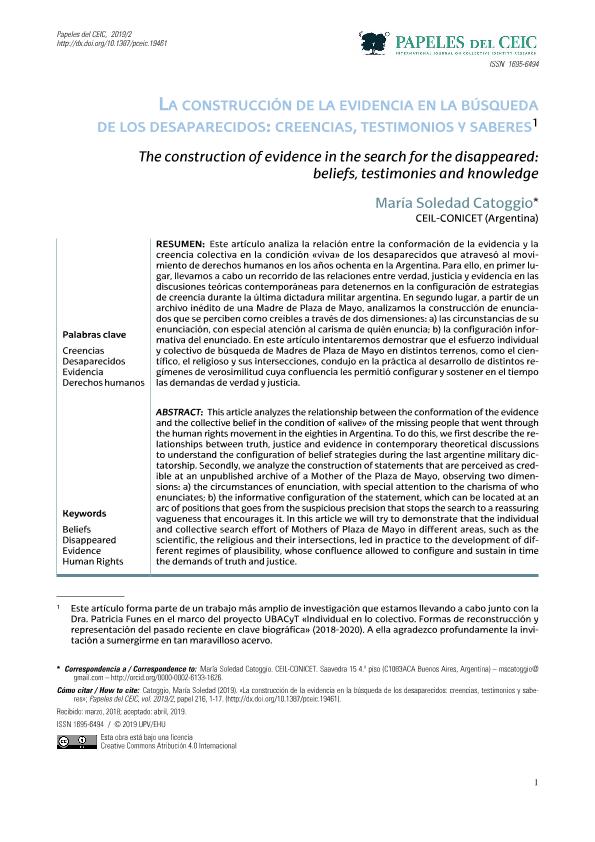Artículo
Este artículo analiza la relación entre la conformación de la evidencia y la creencia colectiva en la condición «viva» de los desaparecidos que atravesó al movimiento de derechos humanos en los años ochenta en la Argentina. Para ello, en primer lugar, llevamos a cabo un recorrido de las relaciones entre verdad, justicia y evidencia en las discusiones teóricas contemporáneas para detenernos en la configuración de estrategias de creencia durante la última dictadura militar argentina. En segundo lugar, a partir de un archivo inédito de una Madre de Plaza de Mayo, analizamos la construcción de enunciados que se perciben como creíbles a través de dos dimensiones: a) las circunstancias de su enunciación, con especial atención al carisma de quién enuncia; b) la configuración informativa del enunciado. En este artículo intentaremos demostrar que el esfuerzo individual y colectivo de búsqueda de Madres de Plaza de Mayo en distintos terrenos, como el científico, el religioso y sus intersecciones, condujo en la práctica al desarrollo de distintos regímenes de verosimilitud cuya confluencia les permitió configurar y sostener en el tiempo las demandas de verdad y justicia. This article analyzes the relationship between the conformation of the evidence and the collective belief in the condition of «alive» of the missing people that went through the human rights movement in the eighties in Argentina. To do this, we first describe the relationships between truth, justice and evidence in contemporary theoretical discussions to understand the configuration of belief strategies during the last argentine military dictatorship. Secondly, we analyze the construction of statements that are perceived as credible at an unpublished archive of a Mother of the Plaza de Mayo, observing two dimensions: a) the circumstances of enunciation, with special attention to the charisma of who enunciates; b) the informative configuration of the statement, which can be located at an arc of positions that goes from the suspicious precision that stops the search to a reassuring vagueness that encourages it. In this article we will try to demonstrate that the individual and collective search effort of Mothers of Plaza de Mayo in different areas, such as the scientific, the religious and their intersections, led in practice to the development of different regimes of plausibility, whose confluence allowed to configure and sustain in time the demands of truth and justice.
La construcción de la evidencia en la búsqueda los desaparecidos: creencias, testimonios y saberes
Título:
The construction of evidence in the search for the disappeared:Beliefs, testimonies and knowledge
Fecha de publicación:
04/2019
Editorial:
Centro de Estudios sobre la Identidad Colectiva
Revista:
Papeles del Centro de Estudios sobre la Identidad Colectiva
e-ISSN:
1695-6494
Idioma:
Español
Tipo de recurso:
Artículo publicado
Clasificación temática:
Resumen
Palabras clave:
CREENCIAS
,
DESAPARECIDOS
,
EVIDENCIA
,
DERECHOS HUMANOS
Archivos asociados
Licencia
Identificadores
Colecciones
Articulos(CEIL)
Articulos de CENTRO DE ESTUDIOS E INVESTIGACIONES LABORALES
Articulos de CENTRO DE ESTUDIOS E INVESTIGACIONES LABORALES
Citación
Catoggio, Maria Soledad; La construcción de la evidencia en la búsqueda los desaparecidos: creencias, testimonios y saberes; Centro de Estudios sobre la Identidad Colectiva; Papeles del Centro de Estudios sobre la Identidad Colectiva; 2019; 2; 4-2019; 216-233
Compartir
Altmétricas




